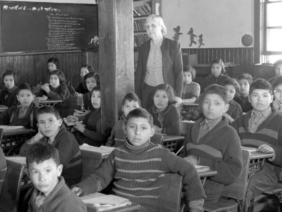
By: Nimisha Jain
When you watch TV today, do you ever notice how often teenagers are portrayed as either drinking or coming up with ways to get their hands on alcohol? We know that adolescence is a time for growth, change, and exploring new aspects of life. Unfortunately, given the influence of social media, television, or even adults in their lives, some teenagers turn to unsuitable substances at a young age. In fact, alcohol is among the leading psychoactive substances consumed in Canada, according to the Canadian Student Tobacco, Alcohol and Drugs Survey (CSTADS, 2017). The most recent CSTADS survey revealed that a whopping 44% of students between Grades 7-12 had consumed alcohol within 12 months prior to the survey. This number increases to almost 65% between Grades 10-12, with the average onset being 13 years of age.
Given the high prevalence of underage drinking in Canadian society, this article sets out to understand why underage youths may consume alcohol, the potential consequences and concerns associated with these actions, and how to prevent underage drinking altogether.
Why do Teens Drink?
In our world, drinking alcohol is normalized; marketed very well; and to some extent glorified on TV (Sargent and Babor 116) and social media (Barry et al. 83). To understand one of the appeals of alcohol to teenagers, you need only consider how many movies or TV shows where alcohol lowers a person’s inhibitions at a party and seemingly increases the chances of a successful social interaction. While research shows that these portrayals lead to more favourable views of alcohol, it is unclear whether this significantly increases underage drinking.
Along the same lines, teenagers may drink to cope with any anxiety or stress they might be experiencing. As mentioned earlier, adolescence is a time of change – physical, emotional, and social. These changes are already turbulent and difficult to manage to begin with. There is also the uncertainty of evolving social context (changing social groups, transitioning from secondary to post-secondary institutions, etc). They may succumb to peer pressure and engage with alcohol to ‘fit in’ with their friends or classmates.
Along with the body, the brain of a teenager is also growing through developmental changes. As such, teenagers also tend to be impulsive and risk-takers, leading them to drink more without thought for consequences (Chung et al. 7). Teen drinking may be a product of simple experimentation out of boredom. Young people also model the behaviour around them (Ward and Gryczynski 366) – if the adults in a family drink, children are more likely to follow their lead (Sargent and Babor 118).
Additionally, alcohol abuse disorders have a genetic component, so if a parent has alcohol addiction, their child is four to ten times more likely to develop an alcohol abuse disorder than a child who does not have alcoholism running in their family (Wong et al. 68). However, it should be strongly emphasized that genetics rarely determine someone’s destiny, and the influence of a person’s environment must be taken into consideration.
Risks of Underage Drinking
Underage drinking poses several threats on multiple levels, ranging from personal to societal. Underage drinking can impact the young drinker’s health. While there isn’t much research on how the human brain is affected, animal research shows that alcohol consumption during critical developmental stages can lead to lifelong cognitive impairments (Sargent and Babor 115). Their liver can also be affected, and in humans, drinking before the body fully develops can lead to a disruption of the hormonal balance necessary for growth. Drinking or even binge drinking can be detrimental for adolescents who already suffer from other disorders such as depression, anxiety, etc., (Chung et al. 8).
Underage drinking can also take a toll on the drinker’s caregiver(s) (Greenfield et al. 1236), as they would have to address any adverse outcomes that may result. Excessive alcohol intake also leads to a state of faulty cognitive functioning called alcohol-induced myopia. This means that a person who has been drinking is unable to fully process the world around them or think about the long-term consequences of their actions. This ‘tunnel vision’ effect of alcohol can also enhance the drinker’s self-image (for example, maybe they think they are more capable of handling their liquor than they actually are).

When both these effects of alcohol myopia are combined, the risk of someone driving under influence (DUI) emerges. They may think they are more sober than they are and not consider the consequences of driving under influence. This threatens not only the driver and his/her passengers but also other drivers and pedestrians on the road. Drinking diminishes attention, motor control of the car, and impairs response time. All these factors increase the odds of getting into a potentially fatal car crash. The drinker’s parent or caregiver would have to deal with the fallout that results from any such situation, which can be very expensive and/or incredibly stressful.
The tunnel vision effect also makes the drinker react as they deem appropriate to a (misinterpreted) salient stimulus. A salient stimulus is one that is more noticeable in your immediate environment (e.g., a splash of red paint on an otherwise blank canvas). For example, they may think that someone who accidentally bumped into them did so on purpose, and then get into a fight. Sometimes, this results in acts of aggression. Vandalism or damage to public property can also be a problem — resources that could have been used elsewhere are used to repair this (avoidable) damage. If an area is identified as high-risk for car crashes, damage to public property, or drunken altercations, it may fall into social disrepute where other people avoid this area at certain times (Greenfield et al. 1237). As we can see, alcohol has more long-term impacts on society than most people consider.
Prevention
There are multiple school-based strategies to reduce the prevalence of underage alcohol use. One is to reduce the personal and social risk factors (which may increase the odds of underage drinking), and another is to boost protective factors (those that decrease the likelihood of adolescent alcohol use). These strategies mainly focus on middle school children and involve disseminating age-appropriate information and skill equipment:
- The short-term and long-term risks of substance abuse are highlighted
- It is emphasized that most teenagers do not use any substances, so these students are not ‘missing out’ by not indulging
- Students are encouraged to identify internal pressures (e.g., stress, anxiety, depression) and external pressures (e.g. peer pressure or advertising)
- Teachers are also trained to identify and address any problem behaviours students display.
- Children are encouraged to enrol in extracurricular youth activities such as sports, recreation, mentoring, etc. This involvement increases safety, communication and life skills while simultaneously reducing risk of juvenile, delinquent behaviours such as drug use.
Students are then equipped with skills to address any pressures or risks. Facilitators provide them with resources to turn to in response to internal pressures (parents, school counsellors, etc.). Through participation-based activities such as role play, children learn how to resist peer pressure.
Komro and Toomey (7) also discuss the role of familial relationships in underage drinking. They propose that positive parent-child relationships based on open communication, problem-solving and active listening are conducive to reducing the risk of underage drinking. They also encourage the use of consistent discipline, rule-making, monitoring activities during adolescence, and family bonding.
On a Policy-Making Level
- Alcohol pricing is a disincentive for underage drinking (Babor et al. 100). In addition to reducing consumption, it also decreases trauma, social issues, and chronic diseases associated with alcohol use.
- Limiting the physical availability of alcohol (e.g., reduced hours at stores) has also been suggested (Giesbrecht et al. 452).
- As teenagers form a large proportion of social media on cell phones, Barry et al. (84) recommend stricter regulations on alcohol advertising on these platforms. Some regulations are in effect, these include age gates on social media, the alcohol brands’ websites, etc.
- Giesbrecht et al. (452) also recommend using only government-run retailing systems (e.g. Liquor Control Board of Ontario) rather than private systems, as they are more likely to curtail service to minors or already intoxicated patrons.
As explained earlier, there should be a focus on the issue of drinking and driving as this may be an issue among impulsive underage drinkers. In Canada, preventative measures include sobriety checkpoints and lower limits on legal blood alcohol concentration (which is 0.00% for novice drivers). Given that reducing the incidence of drinking and driving is a personal and social responsibility, adults should avoid purchasing alcohol for underage youths. As part of familial open communication, it would be beneficial if the youth is able to call a reliable adult to pick them up without the threat of getting in trouble for drinking in the first place. These tactics reduce the risk of underage drinking and driving under the influence.
To sum up, tackling a widespread issue like underage drinking requires effective input from multiple levels — the individual, their family, society, and the government. While we must acknowledge that the prevalence and consequences of underage drinking are dire, with more awareness and action, the situation is improving.
As noted earlier, despite some spikes, the percentage of underage drinking reported in the CSTADS has been steadily decreasing since 2006, even with a slight spike in 2019. There are evidence-based approaches that we can take to prevent the costs of underage drinking to the drinker, their family, and the society they live in. Even as these interventions exist, the responsibility of reducing underage drinking falls on society as a whole. Adolescents need to acknowledge the risks associated with substance use from a younger age and develop the skills to resist peer pressure. It is up to the society around them to cultivate a culture boosting protective factors against underage drinking, and the government’s responsibility to ensure that alcohol and other substances are unavailable to individuals who are not of legal age.
Works Cited
Babor, Thomas F., et al. Alcohol: No Ordinary Commodity: Research and Public Policy. OUP Oxford, 2010.
Barry, Adam E., et al. “Characteristics and Effectiveness of Alcohol Website Age Gates Preventing Underage User Access.” Alcohol and Alcoholism (Oxford, Oxfordshire), vol. 56, 2021, pp. 82–88.
Chung, Tammy, et al. “Adolescent Binge Drinking: Developmental Context and Opportunities for Prevention.” Alcohol Research: Current Reviews, vol. 39, 2018, pp. 5-15.
Giesbrecht, Norman, et al. “Alcohol in Canada: Reducing the Toll through Focused Interventions and Public Health Policies.” CMAJ, vol. 183, 2011, pp. 450–55.
Greenfield, Thomas K., et al. “The Relationship Between the US State Alcohol Policy Environment and Individuals’ Experience of Secondhand Effects: Alcohol Harms Due to Others’ Drinking.” Alcoholism: Clinical and Experimental Research, vol. 43, 2019, pp. 1234-1243.
Komro, Kelli A., and Traci L. Toomey. “Strategies to Prevent Underage Drinking.” Alcohol Research & Health, vol. 26, 2002, pp. 5–14.
Sargent, James D., and Thomas F. Babor. “The Relationship Between Exposure to Alcohol Marketing and Underage Drinking Is Causal.” Journal of Studies on Alcohol and Drugs. Supplement, vol. Sup 19, 2020, pp. 113–24.
Street, Albert. The National Alcohol Strategy Monitoring Project: A Status Report. p. 93.
Ward, Brian W., and Jan Gryczynski. “Social Learning Theory and the Effects of Living Arrangement on Heavy Alcohol Use: Results from a National Study of College Students.” Journal of Studies on Alcohol and Drugs, vol. 70, 2009, pp. 364-372.
Wong, Maria M., et al. “Sleep and Behavioral Control in Earlier Life Predicted Resilience in Young Adulthood: A Prospective Study of Children of Alcoholics and Controls.” Addictive Behaviors, vol. 82, 2018, pp. 65-71.




